If , , are the lengths of the emitter, base and collector of a transistor then
(a)= = (b) <>
(c) < < (d) > >
यदि , , उत्सर्जक, आधार और संग्राहक की लंबाई है, तब -
(a)= = (b) <>
(c) < < (d) > >
(a)= = (b) <>
(c) < < (d) > >
(a)= = (b) <>
(c) < < (d) > >
GaAs is
(a) Element semiconductor
(b) Alloy semiconductor
(c) Bad conductor
(d) Metallic semiconductor
GaAs क्या है?
(a) तत्व अर्धचालक
(b) मिश्रधातु अर्धचालक
(c) कुचालक
(d) धात्विक अर्धचालक
The phase difference between input and output voltages of a CE circuit is
(a) 0 (b) 90
(c) 180 (d) 270
CE परिपथ के निवेश और निर्गत वोल्टेज के मध्य कलांतर की गणना कीजिए:
(a) 0 (b) 90
(c) 180 (d) 270
Choose the correct statement
(a) When we heat a semiconductor its resistance increases
(b) When we heat a semiconductor its resistance decreases
(c) When we cool a semiconductor to 0 K then it becomes super conductor
(d) Resistance of a semiconductor is independent of temperature
सही कथन का चयन कीजिए:
(a) जब हम किसी अर्धचालक को गर्म करते हैं, तो इसका प्रतिरोध बढ़ता है।
(b) जब हम किसी अर्धचालक को गर्म करते हैं, तो इसका प्रतिरोध घटता है।
(c) जब हम किसी अर्धचालक को 0 K तक ठंडा करते हैं, तो यह अतिचालक बन जाता है।
(d) अर्धचालक का प्रतिरोध तापमान से स्वतंत्र होता है।
Which of the energy band diagrams shown in the figure corresponds to that of a semiconductor
1. 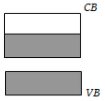
2. 
3. 
4. 
आरेख में दर्शाए गए ऊर्जा बैंड आरेखों में से कौन-सा अर्धचालक के संगत है?
1. 
2. 
3. 
4. 
In a semiconducting material, the mobilities of electrons and holes are and respectively. Which of the following is true?
(a) > (b) <
(c) = (d) <0; >0
अर्धचालकीय पदार्थ में, इलेक्ट्रॉनों और कोटरों की गतिशीलता क्रमशः और है। निम्नलिखित में से कौन-सा सत्य है?
(a) > (b) <
(c) = (d) <0; >0
For the transistor circuit shown below, if = 100, voltage drop between emitter and base is 0.7 V, then value of will be :
1. 10 V
2. 5 V
3. 13 V
4. 0 V
निम्नवत दर्शाए गए ट्रांजिस्टर परिपथ के लिए, यदि = 100, उत्सर्जक और आधार के बीच विभव पतन 0.7 V है, तब का मान कितना होगा?
1. 10 V
2. 5 V
3. 13 V
4. 0 V
The current through an ideal p-n junction diode shown in the circuit will be -
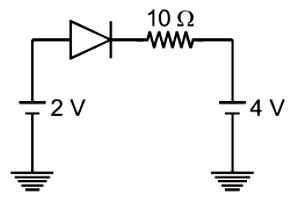
1. 5 A
2. 0.2 A
3. 0.6 A
4. Zero
परिपथ में दर्शाए गए आदर्श p-n संधि डायोड में धारा की गणना कीजिए।
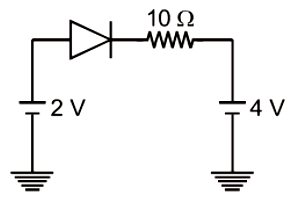
1. 5 A
2. 0.2 A
3. 0.6 A
4. शून्य
In the given circuit power developed in \(1 k \Omega\) resistor is
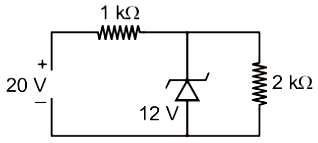
1. 36 mW
2. 12 mW
3. 144 mW
4. 64 mW
दिए गए परिपथ में \(1 k \Omega\) प्रतिरोधक में उत्पन्न शक्ति है:
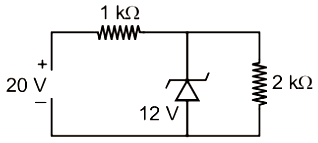
1. 36 mW
2. 12 mW
3. 144 mW
4. 64 mW
The diode shown in the circuit is a silicon diode. The potential difference between the points A and B will be
(a) 6 V
(b) 0.6 V
(c) 0.7 V
(d) 0 V
परिपथ में दर्शाया गया डायोड एक सिलिकॉन डायोड है। बिंदु A और B के मध्य विभवांतर कितना होगा?
(a) 6 V
(b) 0.6 V
(c) 0.7 V
(d) 0 V








